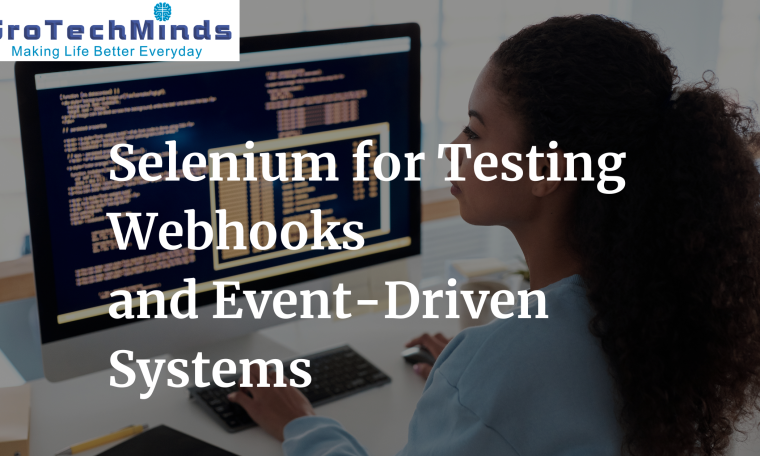
Webhooks and event-driven systems are now essential parts of real-time communication between applications and services in the dynamic world of software development. These systems facilitate a wide range of activities, including notifications, data synchronization, and action triggers depending on predefined events. They also offer smooth automation and integration. To ensure trouble-free operations and reduce potential problems, it is imperative to thoroughly test these systems to ensure their functionality and dependability.
Understanding Event-Driven Systems and Webhooks
Understanding webhooks and event-driven systems is crucial before diving into testing approaches.
Webhooks:
Webhooks are user-defined HaqTTP callbacks that an application can set off to respond to particular events. In order to alert another application or service of an event, the application makes an HTTP POST request to the webhook endpoint, which is a determined URL. Real-time communication and smooth system integration are made possible by this approach.
Systems Driven by Events:
The idea of events and event handlers is central to event-driven architecture. Events are important things that happen or change in an application, and event handlers are in charge of responding to these things by carrying out certain actions that have been established. This asynchronous communication approach allows for flexibility and scalability while supporting loosely linked systems.
Challenges in Testing Event-Driven Systems with Webhooks
Comparing testing webhooks and event-driven systems to typical application testing reveals distinct challenges:
Asynchronous Nature: Because these systems’ events happen asynchronously, it is difficult to forecast when or in what order they will occur. This is a feature that traditional testing methods might not fully address.
Managing External Dependencies: In order to handle events, webhooks frequently rely on external services or APIs. This introduces dependencies, which must be controlled during testing.
Verification of Event Handling: Because the system is event-driven, certain testing methods are needed to make sure that events are handled appropriately and result in the anticipated actions.
Using Selenium to Test Event-Driven Systems and Webhooks
Although Selenium is primarily recognized for automating browser-side
interactions, its adaptability encompasses testing several facets of web
applications, such as event-driven systems and webhooks. Here’s how to
use Selenium to do efficient testing:
-
Monitoring Webhook Endpoints:
Selenium can be used to watch
webhook endpoints by
checking for incoming requests on a regular basis.
Automated scripts can mimic the creation of events within
the source application and confirm if the associated webhook
To verify that assertions are accurate, they might be based on the payload and metadata of incoming webhook requests.
- Validation and Simulation of Events:
Selenium interacts with the user interface or API endpoints that cause events to occur, making it easier to automate the simulation of events.
To replicate different event scenarios and verify the related behavior of the
To ensure that the right actions are
taken in response to various kinds
of events,
assertions can be used.
- Testing Integration with Third-Party Services:
Test scenarios can incorporate external service interactions thanks to Selenium WebDriver’s features.To verify end-to-end functionality, test scripts can
communicate with third-party APIs or services that are
involved in webhook processing.
- Dealing with Asynchronous Activity:
To accommodate the asynchronous nature of event-driven systems,
- Reporting and Logging:
Strong logging and reporting features are provided by automation testing in Selenium frameworks, giving users insight into the performance and outcomes of their tests.
Thorough logs make debugging and troubleshooting easier by allowing you to follow the progression of events and identify problems that arise during testing.
Best Practices for Testing Webhooks and Event-Driven Systems with Selenium
Take into account the following best practices to optimize Selenium’s performance when testing webhooks and event-driven architectures:
Modular Test Design: Use a modular strategy for test design, building reusable parts to validate responses, simulate events, and communicate with outside services.
Parameterization and Data-Driven Testing: To provide thorough test coverage, parameterize test scenarios to account for various event setups and data inputs.
Error Handling and Recovery: To elegantly handle unforeseen circumstances and recover from failures, incorporate strong error-handling techniques into test scripts.
Integration of Continuous Integration and Deployment (CI/CD): Utilize Selenium tests in CI/CD pipelines to Automation testing as a component of the development process,
guaranteeing prompt feedback and early issue discovery.
Environment Isolation: To avoid interference from outside sources and preserve consistency in test findings,
Cross-Browser and Cross-Platform Testing:
Perform testing across different browsers and platforms to ensure compatibility and consistent behavior of webhooks and event-driven systems. Selenium’s cross-browser testing capabilities enable validation of functionality across popular browsers like Chrome, Firefox,
and Safari, as well as various
operating systems.
Performance Testing: While Selenium
is primarily used
for functional testing, it can also be
extended for performance testing of webhooks
and event-driven systems. By simulating a large number of concurrent events and
monitoring system response times, testers can evaluate the scalability and performance under load conditions.
Security Testing: Incorporate security testing into Selenium test suites to identify vulnerabilities related to webhook endpoints and event processing mechanisms. Test scenarios can include checks for input validation, authentication mechanisms,
and protection against common security threats
such as injection attacks and data leakage.
Documentation and Knowledge Sharing: Document test cases, scripts,
and test results to facilitate knowledge sharing among team members and future reference.
Clear and comprehensive documentation ensures continuity in testing efforts
and enables new team members to quickly onboard and contribute to the testing process.
Continuous Learning and Improvement:
Stay updated with advancements in Selenium tooling and testing methodologies through continuous learning and professional development. Engage with the testing community, attend conferences, and explore online resources to gain insights into best practices
and emerging trends in testing webhooks and event-driven systems.
In summary
Automation testing with Selenium is a powerful tool for testing webhooks and event-driven systems because of its many features and adaptability. Testers may efficiently simulate events, verify webhook functionality, and guarantee the dependability of event-driven architectures by utilizing Selenium automation testing features.
Selenium proves to be an invaluable tool for testing the intricate functionalities of webhooks and event-driven systems. By harnessing its capabilities effectively and adhering to best practices, testers can ensure the reliability, scalability, and security of these critical components in modern software applications. As software development continues to evolve, Selenium remains a cornerstone in the arsenal of testing tools, empowering teams to deliver high-quality, resilient software solutions that meet the demands of today’s dynamic digital landscape.



